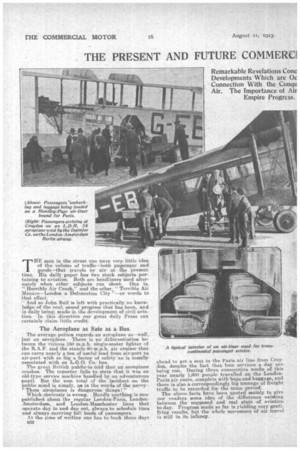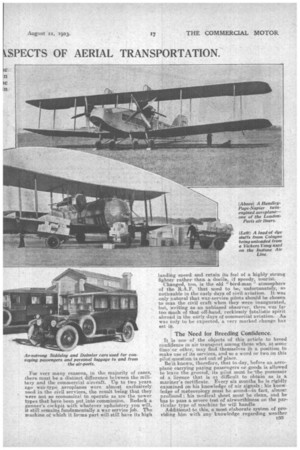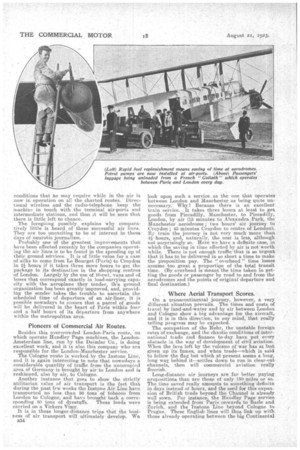THE PRESENT AND FUTURE COMMERC1 SPECTS OF AERIAL TRANSPORTATION.
Page 16

Page 17

Page 18

Page 19

If you've noticed an error in this article please click here to report it so we can fix it.
THE man in the street can nave very little idea of the volume of traffic—both passenger and goods—that travels by air at. ale present time. His dairy paper has two stock subjects pertaining to aviation. Both are headliners used alternately when other subjects run short. One is, " Horrible Air Crash," and the other, " Terrible Air Menace—London a Defenceless City "—or words to that effect.
And so John. Burr is left with practically no knowledge of the real, sound progress that has been, and is daily being, made in the development of civil aviation. In this direction our great daily Press can certainly claim little credit.
The Aeroplane as Safe as a Bus.
The average person regards an aeroplane as—well, just an aeroplane. There is no differentiation between the vicious 150 m.p.h. single-seater fighter of the R.A.F. and the stately 90 m.p.h. air cruiser that can carry nearly a ton of useful load from air-port to air-port with as big a factor of safety as is usually associated with an L.G.O. Ca. bus.
The great British public is told that an aeroplane crashes. The reporter fails to state that it was an old-type service machine handled by an adventurous pupil. But the sum total of the incident on the
publipublic mind is simply, as in the words of the navvy c airoplanes is d-angerous things!" , Which obviously is wrong. Hardly anything is now published, about the regular London-Paris, LondonAmsterdam, and London-Manchester lines that operate day in and day out, always to schedule time and always carrying full loads of passengers. At the time of writing one has to book three days
B32 ahead to get a seat in the Paris air line from Croydon, despite the fact that four services a day are being run. During three consecutive weeks of this year nearly 1,000 people travelled on the LondonParis. air route, complete with bags and baggage, and there is also a correspondingly big tonnage of freight traffic to be recorded for the same period.
The above facts have been quoted mainly, to give. our readers some idea of the difference existing between the supposed and real state of aviation try:day. Progress. made so far is yielding very gratifying results, but the whole movement of air travel is still in its infancy.
For very many reasons, in the majority of cases, there must be a distinct difference bctween the military and the commercial aircraft. Up to two years ago wax-type aeroplanes were almost exclusively used in the civil services, the result being that they IA ere not so economical to operate as are the newer types that have been put into commission. Bedeck a gunner's cockpit with whatever upholstery you will, it still remains fundamentally a war service job. The machine of which it forms part will still have its high landing speed and retain its feel of a highly strung fighter rather than a docile, if speedy, tourist. Changed, too, is the old " bird-man " atmosphere of the R.A.F. that used to be, unfortunately, an noticeable in the early days of civil aviation. It was only natural that war-service pilots should be chosen to man the civil craft when they were inaugurated, but, writing as an unbiased observer, there was far too Much of that off-hand, recklessly fatalistic spirit abroad in the early days of commercial aviation. As was only to be expected, a very marked change has set in.
The Need for Breeding Confidence.
It is one of the objects of this article to breed confidence in air transport. among those who, at some time or other, may find themselves ih a position to make use of its services, and so a word or two on this pilot question is not out of place. Be it known, therefore, that to-day, before an aeroplane carrying paying passengers or goods is allowed to leave the ground, its pilot must be the possessor of a licence that is as difficult to obtain as is a mariner's certificate. Every aix months he is rigidly examined on his knowledge of air signals ; his knowledge of meteorology must be sound—in fact, almost profound ; his medical sheet must be clean, and. he has to pass a severe test of airworthiness on the' par ticular type of machine he will handle . Additional to this, a most elaborate system of providing him with any knowledge regarding weather conditions that he may require while in the air is now in operation on all the charted routes. threetionai wireless and the radio-telephone keep the machine in touch with the terminal air-ports and intermediate stations, and thus it will be seen that there is little left to chance..
The foregoing possibly explains why comparatively little is heard of these successful air lines. They are too unexciting to be of interest inthese days of neurotic journalism. .
Probably one of the greatest improvements that have been effected recently by the companies operating the air lines is to be found in the Speeding up of their ground sel-vices. It is of little value for a case of silks to come from Le Bourget (Paris) to Croydon in 21 hours if it takes three more hours to get the package to its destination in the shopping centres of London. Largely by the use of 10-cwt. vans and of buses that correspond exactly in load-carrying caps. city with the aeroplane they tender, this ground organization has been greatly improved, and, providing the sender takes the trouble to ascertain the scheduled time of departure of an airliner; it is possible nowadaysto ensure that a parcel of .goods will be delivered in the heart of Paris within four and a -half hours of its departure from anywhere within the metropolitan area.
Pioneers of Commercial Air Routes.
.Besides this overcrowded London-Paris route, on which operate Handley Page machines, the LondonAmsterdam line, run by the Daimler Co., is doing excellent work, and it is also this company who are respensible for the Landon-Manchester service.
The Cologne route is worked by the Instone Line, and it is again interesting to note that nowadays a considerable quantity of traffic, from the unoccupied area Of Germany is brought by air to London and is reshipped. also by air, to Cologne.
Another instance that goes to show the strictly utilitarian value of air transport is the fact that during the past few weeks the Instene Air Line have transported no less than 50 tons of tobacco from Londonto Cologne, and have brought back a. corre
sponding 50 tons of dyestnffs. These loads were carried on a Vickers Vimy.
It is in these longer-distance trips that the business of air transport will ultimately develop. We E34
look upon such a service as the one that operates between London and Manchester as being quite unnecessary. Why? Because there is an excellent train service. It takes three hours at least to ge.4 goods from Piccadilly. Manchester, to Piccadilly, Landon, by air (15 minutes to Alexandrayark, the Manchester aerodrome ; two hours' air journey to Croydon ; 45 minutes Croydon to centre of London). By train the journey is not very much more than, 4A–hours, and, naturally, the east is less, although not surprisingly so. Here we have a definite case, in which the saving in time effected by air is not worth while. There is not enough traffic-that is so urgent that it has to be delivere.d an so short a time to make the proposition pay. The " overhead " time losses assume too great aproportign of the total transit time. (By overhead is meant the time taken in getting the goods or passenger by road to and from the aerodromes and the points of original departure anti final destination.) . Where Aerial Transport Scores. .
On a transcontinental journey, however, a very different situation prevails. The tithes and costs of travel by land-and-water and by air between London and Cologne show a big advantage for the aircraft., and it is in this direction, to our mind, that really telling progress may be expected.
The occupation of the Ruhr, the unstable foreign rates of exchange., and the chaotic conditions of international trade and finance to-day have put every obstacle iri.the way of development of citil aviation. When the lava left by the volcano of war has at last given up its fumes, and when trade—which is said to follow the flag but which at present seems a long, long way, behind it—settles down to run in clear-cut channels, then will commercial aviation really flourish.
Long-distance air journeys are far better paying propositions than are those of only 150 Miles or so. The time saved really. amounts to something definite in days instead of hours, and the seed.for this expansion of British trade beyond the Channel is already well sow-n. For instance, the Handley Page service is being extended from Paris onwards to Ba,SIe and -Zurich, and the Instone Line beYand Cologne to Prague. These English lines will thus link up with those already operating between the big Continental cities, whilst, farther south, a line is already in progress of development that will link up London with Italy, Egypt, Baghdad, and India. The prospect of a merchant being able to send 10 tons of samples or goods from London on a Man, day to arrive at Bombay on the Thursday is distinctly hopeful for Empire trade. The Government subsidized airship scheme that is being inaugurated by Commander Burney will snake this possible. So soon as the airship proves itself—as it can arid will—the next step will be the picking up and setting down of passengers en route by aeroplanes that will land on and take off from the airship top just as surely as they now land on the decks of battleships in mid-ocean. A flight of imaginative fancy Not at all.. Such a feat is, aerodynamically, More straightforward than things that have already been
done. . .
Returning from the futiire to the present, another phase cif civil flying that must not be overlooked is the " taxi" service, run bY the De Havilland Co., a Stag Lane,Edgware. The machines of this concern are mostly twoor three-seaters. They operate over no definite routes and run at no definite times, hut are just taxis pure and simple. Goads to Scotland, passengers to Cairo, commercial visits to Sweden, holiday-ma.kers to Ostend—all is done at a flat rate of about 2s. 6d. per mile " all in " and at a speed of 90 m.p.h.—which, incidentally, -is the normal Cruising pace of most commercial aircraft to-day and can generally be taken as the average 'drome-to2drorne schedule. The De Havilland service. is very interesting, in that it shows that ordinary,• workaday, common or garden people will use air transport freely, providing it is at their beck and cal! when they want it; which, in turn, means that when air services become more common. and run several times a day they will automatiCally become more useful and more used Secondly, the taxiplane service pays its own way, being unsubsidised by the Government as are the other " air-lines," showing that an long distances especially air transport will be cheap and worth while. There is no doubt that the British.I'sles are now no longer islands, and, from the point of view of com.-;' raereial development, the aeroplane and 'aircraft ice general are, and will be, very potent faetor's in our national life. Aviation is a subject that must be reprded as a concrete force and not as an abstract interest. One must look farther than sensational headlines. Coupled with development in wireless telephony, aviation Will hasten transport of passengers, goods, and trade of all sorts to a pace unthaught of to-day. This world of ours is going to speed itself up, and at the same time shrink apPreciably during the next :30 years, and it behoves every live business man to keep in touch with all means that tend to achieve this end.




























